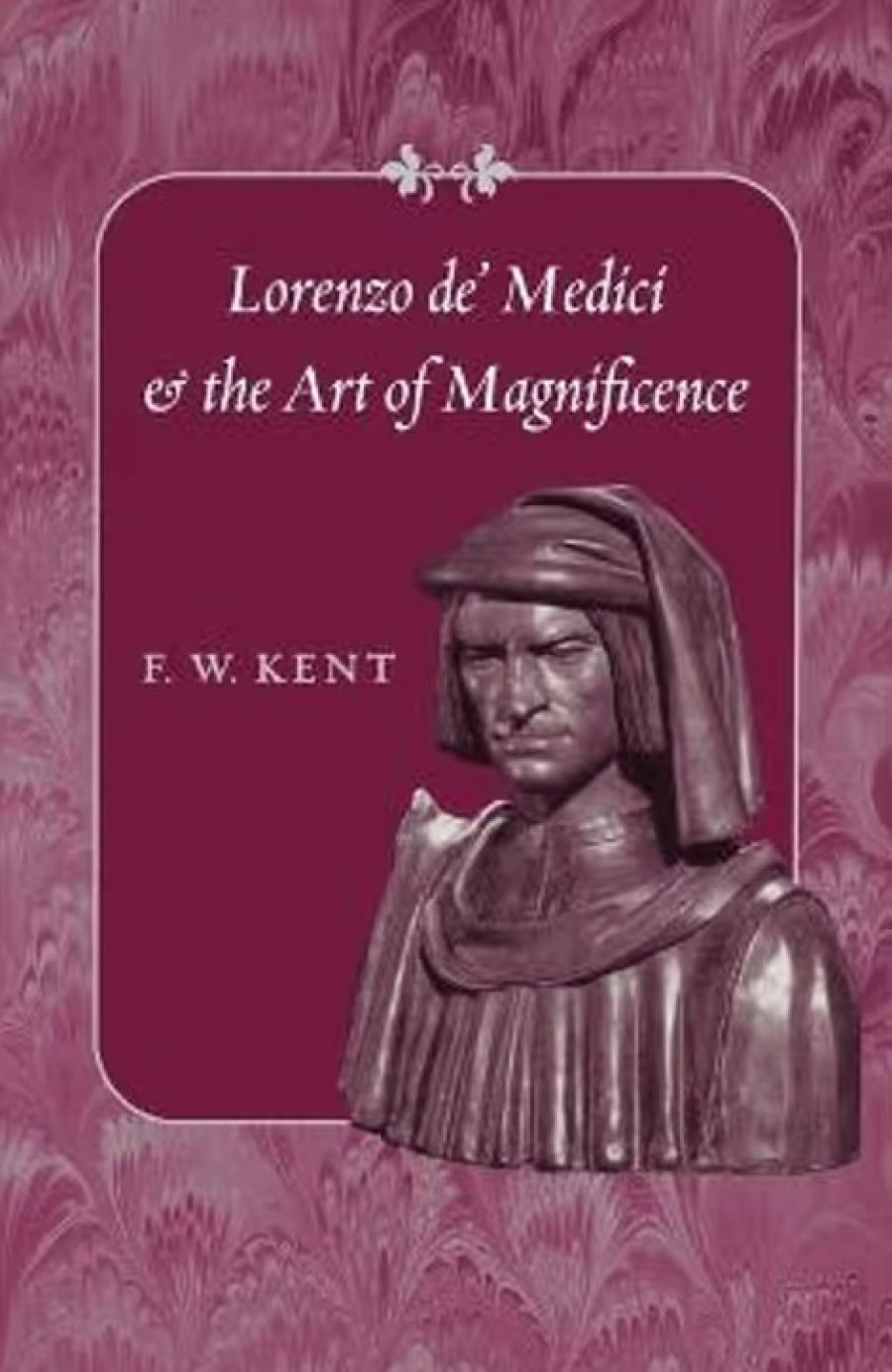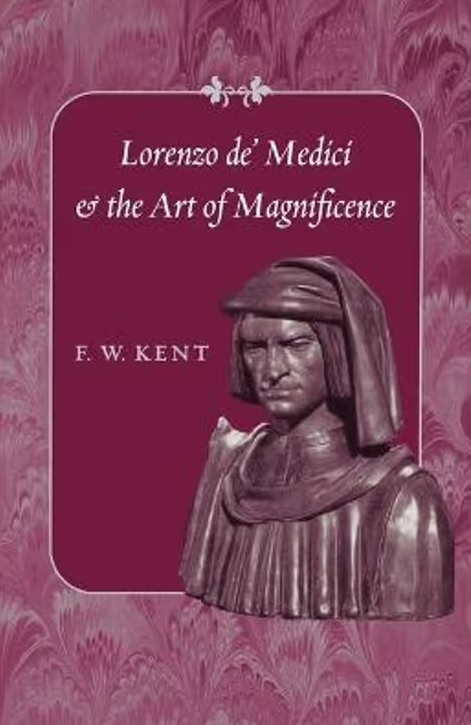
- Free Article: No
- Contents Category: History
- Review Article: Yes
- Article Title: II Magnifico
- Online Only: No
- Custom Highlight Text:
In October 2005, Monash University hosted a workshop on Australians in Italy at its Centre in the Palazzo Vaj in Prato. Australians in Italy were certainly visible in the week of the conference. Wall posters in Rome advertised the Macquarie Bank and an exhibition, Viaggio nella Provincia di Roma di una pittrice australiana, the paintings of the expatriate artist Janet Venn-Brown. In Florence, the invitation to the opening of an international exhibition of Women’s Art bore the image of Tracey Moffatt’s photograph Something More 1 (1989). The workshop in Prato included papers on artists, writers, returned migrants, the Catholic clergy – and a vignette on the best-known Australian in contemporary Italy, the supermodel Megan Gale. Also on the programme was the contribution of Australian scholars to Italian Renaissance studies. Now extending to three generations, their work is no longer subsumed under ‘British’, and references are to ‘American–British–Australian’ approaches and research. A member of the first generation, Bill Kent, through his own writing and his training of PhD students, is the crucial figure in the ‘piccola scuola australiana’ (‘piccola’ only when confronted with the North American Renaissance industry), just as he was in the establishment of the Monash Centre in Prato.
- Book 1 Title: Lorenzo De’ Medici And The Art Of Magnificence
- Book 1 Biblio: Johns Hopkins University Press, US$36.95 hb, 230 pp
- Book 1 Cover Small (400 x 600):

- Book 1 Cover (800 x 1200):

Originally concerned with the social history of Florence, Kent’s first work was a study of three fifteenth-century Florentine aristocratic lineages, a work that challenged the conventional view that the nuclear family had replaced the lineage as the basic social institution in Florence. That the conventional view now appears so quaint is in no small part the result of Kent’s pioneering study. From the social unit of the family, Kent went on to explore the second pillar of the Florentine social structure in his studies of neighbourhood, the vicini. In recent years, he has turned his attention more and more to the third pillar, amici, in his studies of that all-encompassing Renaissance modus operandi, patronage. Kent’s interest in the great lineages led him to the family palaces that dominated local neighbourhoods, and to architecture and art. His focus is now on that fifteenth-century Florentine patron-in-chief, Lorenzo de’ Medici, and in Lorenzo de’ Medici and the Art of Magnificence, based on the James S. Schouler Lectures that he delivered at the Johns Hopkins University, Kent makes a compelling case for Lorenzo as a great builder and champion of the new Renaissance style all’antica, so evident in the work of his principal architect, Giuliano da San Gallo. The role of Lorenzo de’ Medici – factional boss, political leader, aspiring prince, famed patron of the arts – is one that has long fascinated connoisseurs of Florence, both professional and amateur. Two myths have been attached to Lorenzo, both stemming from his own lifetime. The black and political myth portrays him as the destroyer of Florentine ‘libertas’; the white and cultural myth is of Lorenzo as the immaculate connoisseur and exemplary patron of the arts, creator of the Italian Renaissance. The latter myth lost its sway among art historians in the second half of the twentieth century when scholars of the repute of Ernst Gombrich compared the extent of Lorenzo’s patronage of art and architecture unfavourably with that of his grandfather Cosimo; pointed to the very few commissions for buildings and works of art that could be conclusively traced to Lorenzo; and dismissed legends such as that of the sculpture workshop in the Medici gardens near San Marco where the young Michelangelo worked and was ‘discovered’. This Medici leader was more interested in collecting objets d’art than in commissioning works from contemporary artists, more concerned ‘to be an ultrarefined arbiter of elegance than to be an active patron’.
As Kent argues, newly discovered evidence and new readings suggest that, if not quite the patron of mythmakers, Lorenzo was a more informed and active patron than his critics have allowed. The Medici sculpture garden, with its collection of antique statues, did indeed exist, and, given that the young Michelangelo was known to Lorenzo, ‘there is nothing inherently unlikely in the mid sixteenth-century tradition that several exceptionally talented young artists, Michelangelo included, were encouraged by Lorenzo and his circle in the Medici garden’.
Kent subtly steers his arguments between the cultural myth of Lorenzo and its critics to persuade the reader that II Magnifico did indeed have a very wide and informed knowledge and appreciation of what we know as the visual arts, and did have a notable career as a builder and artistic patron. But Lorenzo died comparatively early, at the age of forty-one, before many of the great building plans on which he had embarked were begun, let alone completed. The magnificent and urbane country villa of Poggio a Caiano is a reminder of what might have been – or of what was to come.
In two notable ways, Lorenzo’s building plans marked new departures: in the city he had begun extending Medici patronage outside the family’s base in the district of San Giovanni; and in the country beyond the ancestral holdings in the Mugello, acquiring land and building, or planning to build, across Florence’s dominion. It was in the countryside, beyond the daily scrutiny of his fellow citizens, that Lorenzo could allow his imagination – and his dynastic ambitions – more scope, could indulge more openly in the production of magnificence. Yet there was always restraint; Lorenzo’s villas surveyed rather than dominated the surrounding countryside.
What underpins Kent’s study and gives it so much of its authority is his unrivalled understanding of fifteenth-century Florentine patronage and his unpacking of contemporary understandings of arte. Lorenzo de’ Medici was an adroit political patron, but, as Kent argues, it is simply beside the point to ask whether his preoccupation with arts and learning, his cultural patronage, was part of the process of political management through which he sought to dominate Florence: ‘for Lorenzo and his contemporaries would not have distinguished, indeed could not have distinguished, between the worlds of the arts and politics in this way.’ As to Lorenzo’s ultimate political ambitions, it is his early death again that, if not interrupting his plans, has left a tantalising problem for historians. But Kent is surely right when he argues that if Lorenzo’s intention was to make himself lord of Florence, his cultural programme ‘was a highly intelligent paving of the way, a seamless weaving together of his deepest aesthetic and political impulses’.
To his representation of Lorenzo de’ Medici, Kent has brought the breadth and depth of knowledge furnished by his nigh on forty years’ research in the archives and libraries of Florence, an extraordinarily sensitive ear for the voices of his fifteenth-century Florentines, a nuanced and subtle understanding of their society and its leading figure, and a Renaissance elegance of structure and writing. Lorenzo de’ Medici and the Art of Magnificence is the prelude to the two-volume study of Lorenzo which Kent is shortly to publish. If the present study is a foretaste, then these volumes are to be anticipated, not only by students of Renaissance Italy but also by all those interested in the interplay of cultural patronage and politics.


Comments powered by CComment